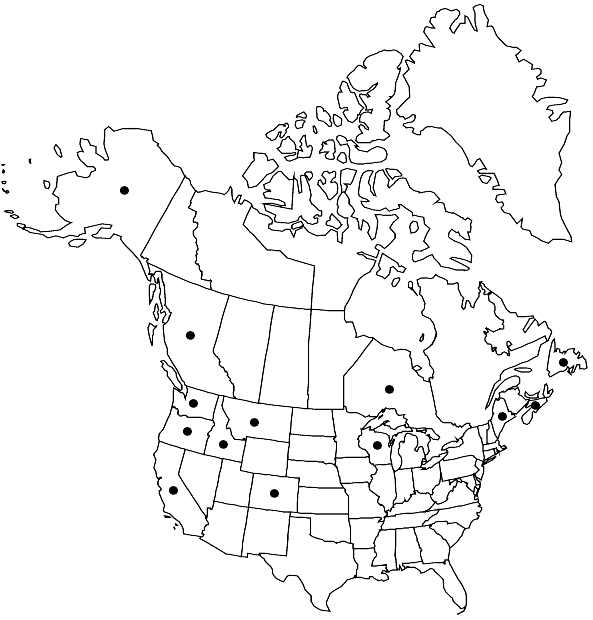Bucklandiella affinis
in R. Ochyra et al., Cens. Cat. Polish Mosses, 144. 2003,.
Plants medium-sized to fairly large, rather slender, loosely caespitose or forming extensive patches, dull green to yellowish or blackish in the upper part, brownish or blackish brown proximally, sometimes hoary. Stems 5–7 cm, erect to decumbent, sparsely or profusely subpinnately branched, rarely quite unbranched. Leaves loosely appressed, straight or secund when dry, erect-spreading to spreading when moist, lanceolate, channeled along the costa, (1.7–)2.3–3.2(–4) (with a hair-point) × 0.5–0.8 mm; margins entire, smooth or somewhat wavy in the distal half, recurved to revolute on both sides to the apex, 1-stratose distally or with 2-stratose patches, seldom predominantly 2-stratose near the apex in 1 cell row; epilose or piliferous, awns erect-flexuous, more yellowish than whitish, flattened, (0.1–)0.5–1.1 mm, low-denticulate at the margins and occasionally spinulose at the abaxial side, usually not or slightly decurrent; costa percurrent or shortly excurrent into the awn, prominently convex abaxially, 80–100(–110) µm wide at the base, 60–70 µm wide distally, 3–4-stratose with 5–7 adaxial cells in the proximal portion, 3-stratose in the middle with 3–4 adaxial cells and 2–3-stratose distally with 2–3 cells on the adaxial side; laminal cells 1-stratose, not or slightly bulging on both adaxial and abaxial sides; basal laminal cells elongate, 15–35 × 7–10 µm, with thick and sinuose-nodulose walls; alar cells usually slightly differentiated, yellowish, sometimes forming a small, auriculate group of wider cells; supra-alar cells undifferentiated, not forming a marginal border; upper and medial laminal cells rectangular to isodiametric, 10–25 × 7–10 µm. Inner perichaetial leaves ovate, hyaline, epilose. Seta brown, 4–10 mm. Capsule brown, somewhat lustrous, shortly cylindric, rarely obloid or ovoid, 1.5–3.2 × 0.6–0.8 mm; operculum long-rostrate, to 1.5 mm; peristome teeth 200–400 µm, reddish brown, papillose, mostly discontinuously divided into 2 prongs by median perforations, arising from a low basal membrane, to 30 µm high. Spores 12–20 µm.
Habitat: Acidic, moist or periodically dry, shady or exposed sites
Elevation: low to high elevations (0-3000 m)
Distribution

B.C., Nfld. and Labr. (Nfld.), N.S., Ont., Alaska, Calif., Colo., Idaho, Maine, Mont., Oreg., Wash., Wis., Europe.
Discussion
Bucklandiella affinis is bicentrically distributed in North America with the main centre of its occurrence in the western part of the continent. There it is widely distributed in coastal areas from the Aleutian Islands to northern California and in the Rocky Mountains, southwards to Montana, Idaho, and Colorado. In eastern North America the species is widely distributed but scattered in the Great Lakes Basin, Newfoundland, Nova Scotia, and Maine. It is a dull blackish green moss with strongly differentiated, hyaline innermost perichaetial bracts, broad and strongly convex abaxially costae, not or weakly differentiated alar cells, and leaf margins that are recurved to revolute on both sides to the apex and predominantly 1-stratose in the distal portion. The species is closely related to B. heterosticha and the differences between them are discussed under the latter. It is unlikely to be mistaken with other species of the B. heterosticha complex and is easily distinguished from B. sudetica and B. venusta, which have mostly 2-stratose leaf margins in the distal part. Bucklandiella microcarpa shares with B. affinis 1-stratose leaf margins, but is readily recognized by having a prominent, pellucid basal marginal border of thin-walled and not sinuose cells.
Selected References
None.